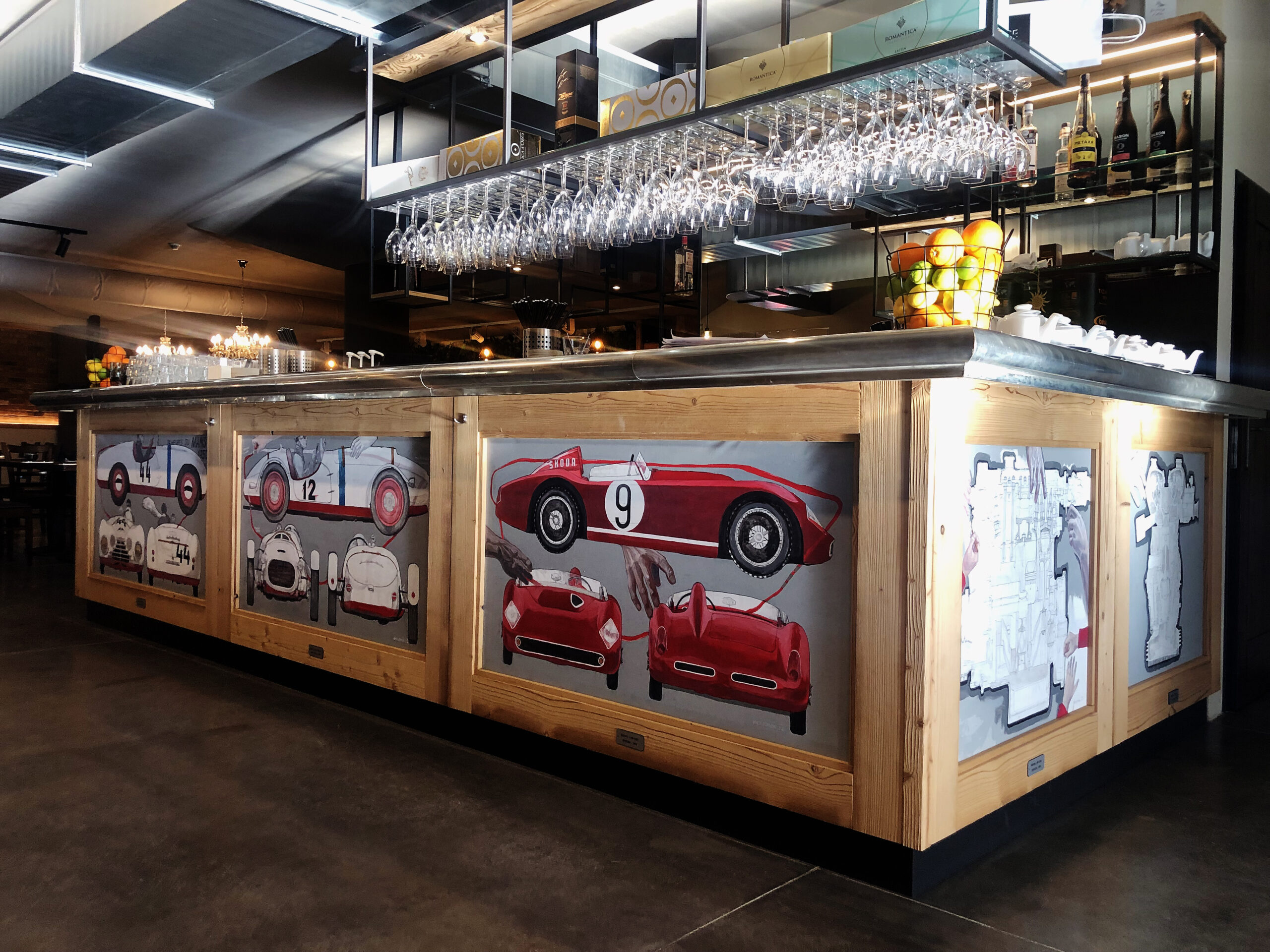
I chose a hagiographic polyptych for the new restaurant Garage Osteria in Pilsen. A series of nine paintings shows the development of the Škoda car in the post-war years, from the Škoda Tudor to the Škoda OHC 1100. The premises of the new restaurant are in an industrial reinforced concrete building, where ŠKODA AUTO cars have been services for the past 60 years. Garages and car workshops are still located on premises. In addition, the owner of the restaurant mentioned the connections between the time of the construction of the building and the effort of the car designers to participate in the “24 hours of Le Mans” race in France. As the name of the series of paintings reveals, the leitmotif is hands and machines. Hands, since without them no cars would be created. Hans are, together with tools, the most important item in every garage/car workshop. Machines are what these hands create and are drive by them, and machines, in turn, drive us. In other languages, the word machine is interchangeable with the word engine, which is the heart of every automobile. The name of the series is in Italian because the paintings decorate an Italian restaurant Osteria, the concept and design of which (interior and exterior) we created with the owner of the restaurant when the first such restaurant in Pilsen – Martinská Osteria – was created. There, the bar is decorated with pictures of beautiful knees and pasta, in a dueling match.
The first part of the Garage Osteria polyptych is a tetraptych (a set of four paintings) – it depicts the development of Škoda as it was started immediately after the war, when the model Tudor 1101 (from English two-door) from 1946 followed on from the most successful pre-war Škoda Popular model (produced by in the years 1933-1946).
Painting 1 – Škoda Tudor 1101 (year 1946) – the inspiration were the drawings (plan, front and side view) of this model-car, into which I placed the female model-driver as the car was promoted in period advertisements. The hand of the “creator” and the hands of watching fans appear in the image.
Painting 2 – Škoda Felicia (year 1959) – a longitudinal section of the car, or a kind of an x-ray image revealing all the necessary and good things that the female model-driver (a reference to Miss. USA Charlotte Sheffield) carries with her.
Painting 3 – Škoda 450 (year 1957) – side view of the red convertible, which also appears in the black and white large-format photos by Antonín Kratochvíl, hanging in the restaurant. Especially the moment when a woman gets up during the ride and removes her scarf from her hair.
Painting 4 – Charlotte Sheffield (year 1957) – Charlotte Sheffield of Utah, USA, became Miss USA in 1957. It was then that she was approached to take promotional photos of the new Škoda 450 car by Pilsen photographer Vilém Heckel, who created a series of iconic black-and-white photos with her.
The second part of the painting series is a triptych (a set of three paintings) – it is the period in which racing cars were developed, aspiring to participate in the famous Le Mans race.
Painting 5 – Škoda Sport LE MANS (year 1950) – side, front and rear view of the car, superimposed over the route of the Le Mans race, which runs like a red thread (or lipstick line) through all three images. This car was placed second throughout the race until…
Painting 6 – Škoda Supersport “Cigar” (year 1950) – side, front and rear view of the improved Škoda Sport model, stripped of fenders, which turned it into the so-called “cigar” shape. Due to the communist regime, it was no longer possible to race in Le Mans and follow up on the success of the previous model.
Obraz 7 – Škoda 1100 OHC (rok 1957) – boční, přední a zadní pohled modelu vozu v ikonické červené barvě, odkazující na závodní červenou „rosso corsa“ italských automobilů.
Painting 7 – Škoda 1100 OHC (year 1957) – side, front and rear view of the car model in the iconic red color, referring to the racing red “rosso corsa” of Italian cars.
The third part of the series of images is a diptych (a set of two images) – sections of the Škoda 1100 OHC engine.
Painting 8 – Škoda 1100 OHC (year 1957) – longitudinal section of the engine.
Painting 9 – Škoda 1100 OHC (year 1957) – cross section of the engine.









